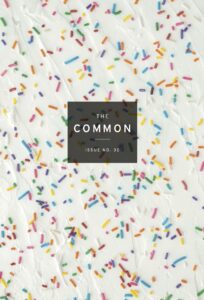 Why Teach The Common?
Why Teach The Common?
Teach The Common in your classroom and receive discounted subscriptions, a free desk copy, and lesson plans.
A classroom subscription includes two issues for every student, and a virtual class visit from Editor in Chief Jennifer Acker or a participating author.
Learn more about teaching The Common or contact us for more options.
Supplementary materials for teaching Issue 30 are listed below.
To accompany our portfolio of translated poetry and art from Ukraine
Explore our collected resources and lesson plans on literary translation, along with our extensive selection of published works by Ukrainian writers—including a feature on Ukrainian poets and their writing during a time of great difficulty.
The Russia-Ukraine war began in 2014 after Russia annexed Crimea and escalated in 2022 when Russia launched a full-scale invasion of Ukraine. The conflict has reshaped global security, disrupted energy and food supplies, and drawn widespread international condemnation. Students can read more about the background and current developments here (via Council on Foreign Relations).
For further exploration, here and elsewhere (non-portfolio)
After reading Laura Geringer Bass’s “Mermaid of Longnook,” students who are curious about the Alsatian Dancing Plague of 1518 that is briefly mentioned in the piece, can learn more here.
After reading “Future Remains: The Mysterious Allure of a Town in Ruins,” by Cush Rodríguez Moz, learn more about Villa Epecuén and the last inhabitant of Argentina’s flooded city.
After reading Allison Funk’s “At Newgrange on the Winter Solstice” students can view pictures of Newgrange through the ages.
If, after reading the interview between The Common’s editor-in-chief Jennifer Acker and author Teju Cole, students are curious about Cole’s anecdote about the river Evros, they can explore this investigative piece on the difficult history of migrants crossing the river (via Forensic Architecture).
If you liked Carson Wolfe’s Disquiet Prize winner “Every Other Weekend,” you can read more of their work published online in The Common, including a June 2024 Poetry Feature.
In “Body Stories: On Miscarriage and Cancer,” Rebecca Worby writes about Moab, Utah, once a uranium boom town. Students curious to learn more can read about how its citizens are working to undo that legacy here (via Popular Science).
For students drawn to Wyatt Townley’s “Waiting for the Call I Am,”The Common offers more of her work published over the years, including a September 2016 Poetry Feature.
Students interested in reading more of Casey Walker’s work after ‘Islands’ can find his piece “Vigilância” in Issue 20 of The Common, along with an accompanying podcast conversation with managing editor Emily Everett.
Students reading Anna Maria Hong’s “Castanets 84 | Being Fond on Praise” can follow it with the William Shakespeare poem that inspired it (via the Folger Shakespeare Library).
Students reading Lawrence Joseph’s “Mind Drifts” can learn more about topics such as the Wall Street Bombing of 1920 (via Britannica) and Pablo Picasso’s portrait of poet Gertrude Stein and their friendship (via Sotheby’s).
Lawrence Joseph’s “The Currency of an Industrial-Scale Slaughter” mentions Lavender, an AI system used by the Israeli government to identify potential Palestinian targets for airstrikes in the weeks following October 7. Students can learn more here (via El País).
After reading Martha Cooley’s “The Melnikov House,” students can view photos of the landmark (via ArchDaily). Additionally, students can read more of Martha Cooley’s work online at The Common.
See all of Issue 30.
Don’t miss: Genre-based Anthologies | Participating Authors | Lesson Plans | FREE Sample Issue | What Teachers Are Saying
